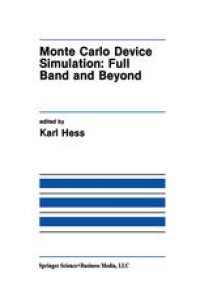
Ebook: Monte Carlo Device Simulation: Full Band and Beyond
- Tags: Electrical Engineering, Numeric Computing, Solid State Physics, Spectroscopy and Microscopy
- Series: The Springer International Series in Engineering and Computer Science 144
- Year: 1991
- Publisher: Springer US
- Edition: 1
- Language: English
- pdf
Monte Carlo simulation is now a well established method for studying semiconductor devices and is particularly well suited to highlighting physical mechanisms and exploring material properties. Not surprisingly, the more completely the material properties are built into the simulation, up to and including the use of a full band structure, the more powerful is the method. Indeed, it is now becoming increasingly clear that phenomena such as reliabil ity related hot-electron effects in MOSFETs cannot be understood satisfac torily without using full band Monte Carlo. The IBM simulator DAMOCLES, therefore, represents a landmark of great significance. DAMOCLES sums up the total of Monte Carlo device modeling experience of the past, and reaches with its capabilities and opportunities into the distant future. This book, therefore, begins with a description of the IBM simulator. The second chapter gives an advanced introduction to the physical basis for Monte Carlo simulations and an outlook on why complex effects such as collisional broadening and intracollisional field effects can be important and how they can be included in the simulations. References to more basic intro the book. The third chapter ductory material can be found throughout describes a typical relationship of Monte Carlo simulations to experimental data and indicates a major difficulty, the vast number of deformation poten tials required to simulate transport throughout the entire Brillouin zone. The fourth chapter addresses possible further extensions of the Monte Carlo approach and subtleties of the electron-electron interaction.
Content:
Front Matter....Pages i-x
Numerical Aspects and Implementation of theDamoclesMonte Carlo Device Simulation Program....Pages 1-26
Scattering Mechanisms for Semiconductor Transport Calculations....Pages 27-66
Evaluating Photoexcitation Experiments Using Monte Carlo Simulations....Pages 67-97
Extensions of the Monte Carlo Simulation in Semiconductors to Fast Processes....Pages 99-121
Theory and Calculation of the Deformation Potential Electron-Phonon Scattering Rates in Semiconductors....Pages 123-160
Ensemble Monte Carlo Investigation of Nonlinear Transport Effects in Semiconductor Heterostructure Devices....Pages 161-189
Monte Carlo Simulation of Quasi-One-Dimensional Systems....Pages 191-218
The Application of Monte Carlo Techniques in Advanced Hydrodynamic Transport Models....Pages 219-266
Vectorization of Monte Carlo Algorithms for Semiconductor Simulation....Pages 267-284
Full Band Monte Carlo Program for Electrons in Silicon....Pages 285-307
Back Matter....Pages 309-310
Content:
Front Matter....Pages i-x
Numerical Aspects and Implementation of theDamoclesMonte Carlo Device Simulation Program....Pages 1-26
Scattering Mechanisms for Semiconductor Transport Calculations....Pages 27-66
Evaluating Photoexcitation Experiments Using Monte Carlo Simulations....Pages 67-97
Extensions of the Monte Carlo Simulation in Semiconductors to Fast Processes....Pages 99-121
Theory and Calculation of the Deformation Potential Electron-Phonon Scattering Rates in Semiconductors....Pages 123-160
Ensemble Monte Carlo Investigation of Nonlinear Transport Effects in Semiconductor Heterostructure Devices....Pages 161-189
Monte Carlo Simulation of Quasi-One-Dimensional Systems....Pages 191-218
The Application of Monte Carlo Techniques in Advanced Hydrodynamic Transport Models....Pages 219-266
Vectorization of Monte Carlo Algorithms for Semiconductor Simulation....Pages 267-284
Full Band Monte Carlo Program for Electrons in Silicon....Pages 285-307
Back Matter....Pages 309-310
....